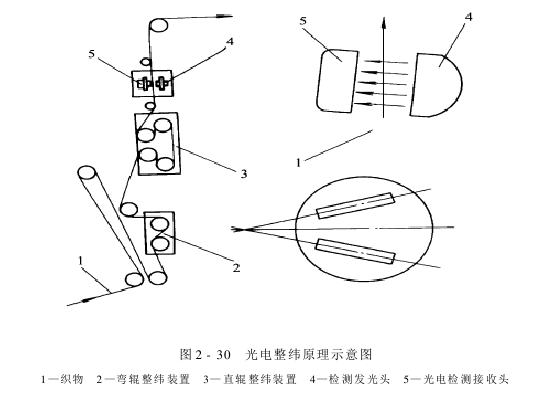The above weft straightening devices all require manual operation. Because the cloth speed is too fast, continuous observation can easily cause eye fatigue, the operation speed will slow down, the sensitivity will decrease, and the labor intensity will be high and the efficiency will be low. Photoelectric weft trimmer can solve these problems very well.
The photoelectric weft straightener combines a straight straight roller, a curved roller, and a flexible roller to straighten the weft by automatically detecting the weft inclination. It consists of three parts: photodetector, controller and actuator. As shown in Figure 2-30.

There are usually 2, 3 or 4 photodetectors, which are installed in the left, middle, right or left position of the whole frame. Each photodetector consists of a detection light-emitting head and a photoelectric detection receiving head, which are installed on the front and back of the fabric. The detection light-emitting head consists of a light source and a lens.
The light source of some light-emitting heads can be divided into two levels, which can be selected according to the fabric thickness, weft density, color, etc. The photoelectric detection receiving head is composed of a light shield, a cylindrical lens, a slit plate, and a silicon photocell. It is a set of optical components. Each slit piece has slits distributed in a single or double figure-of-eight shape. The single figure-of-eight slits are mostly ±6°, and the double figure-of-eight slits are ±6°, ±10°, ±4°, and ±9. °, ±7° and ±14°. The appropriate angle can improve the detection accuracy and expand the detection range.
When the parallel light emitted by the detection light-emitting head passes through the moving fabric, enters the signal receiving head, and is projected onto the silicon photovoltaic cells, if there is no latitude skew, the amount of light received by each silicon photovoltaic cell is equal; The amount of light passing through the slit changes, resulting in differences. Each silicon photocell produces different electrical signals. These signals are amplified, calculated, and adjusted and then input into the control actuator. Two motors drive the weft straightening device to achieve the purpose of weft straightening.
Characteristics of photoelectric weft trimmer:
(1) Low labor intensity and high productivity.
(2) It can automatically and continuously inspect, with high sensitivity, which can prevent missed inspections and improve product quality.
(3) The weft-setting effect is poor on thick, dark-colored fabrics with poor light transmittance and twill fabrics.
(4) The electrical circuits are complex and require high preservation and maintenance requirements.
AAA flame retardant fabric network NHGMKJLOI87






